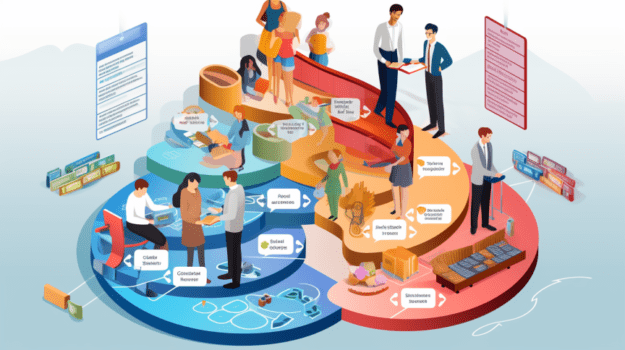Introduction
Over the years, the landscape of education has dramatically shifted, with online learning emerging as a significant player in this evolution. The virtual classroom offers its unique benefits and challenges, quite distinct from the traditional brick-and-mortar educational settings. A key challenge facing educators and learners in this sphere is maintaining robust student engagement in an environment that is devoid of physical interactions. This comprehensive article aims to provide a deeper understanding of online learning and its associated challenges. We will explore various strategies to enhance student engagement and delve into the role that engaging educational materials and active learning techniques play in this context.
Decoding Online Learning

The first step to tackling the challenges of online learning is understanding its intricacies. Online learning typically falls into two categories: synchronous and asynchronous. Synchronous learning is real-time, requiring students and instructors to be online simultaneously, much like a traditional classroom but conducted via the internet. Asynchronous learning, on the other hand, allows students to access materials and complete assignments on their own schedule.
Each mode has its pros and cons. Synchronous learning promotes real-time interaction and immediate feedback, but it can be restrictive due to scheduling issues. Asynchronous learning offers flexibility and convenience, but it can potentially lead to feelings of isolation due to the lack of real-time interaction.
Online learning is highly dependent on technology. Essential components include Learning Management Systems (LMS) that organize and deliver course materials, and tools like video conferencing software for real-time discussions and presentations. The role of technology extends to creating an interactive environment, encouraging student participation, and providing mechanisms for tracking student progress and engagement.
The Crucial Role of Student Engagement in Online Learning

Student engagement refers to the degree of attention, curiosity, interest, and passion that students show when they are learning. It encapsulates emotional investment, active participation, and a strong motivation to learn. Engagement is vital as it directly influences learning outcomes and overall student success.
Research shows a strong correlation between high levels of student engagement and better grades, increased retention rates, and improved job prospects after graduation. An engaged student is more likely to understand and retain the learning material, perform well acadically, and stay motivated throughout their course.
Challenges to Student Engagement in an Online Learning Environment

However, fostering student engagement in an online environment comes with its own set of hurdles. Limited face-to-face interaction can lead to a lack of social bonding, making students feel isolated. Online learning demands strong self-discipline, and distractions like social media, television, or other activities can easily veer students off their course. This lack of interaction and increased potential for distraction makes it crucial for educators to strategize and implement effective methods to keep students engaged.
Strategies to Boost Student Engagement in Online Learning

Crafting a productive online learning experience requires a thoughtful approach. Clear instructions and well-defined expectations can alleviate student anxiety and confusion. A tailored learning plan, customized to each student’s learning style, pace, and interests, can significantly improve their engagement levels.
Incorporating a variety of multimedia tools like videos, infographics, and virtual tours can make the learning material more captivating. Encouraging communication and collaboration among students fosters a sense of community, alleviating feelings of isolation. Regular feedback and recognition for students’ efforts bolster their motivation and dedication towards the course.
Developing Engaging Online Learning Materials

The design and content of learning materials can greatly impact student engagement. Visually appealing materials with graphs, charts, or images can pique students’ interest. Storytelling and narrative elements can make complex topics more relatable and easier to understand.
Real-world examples can contextualize the learning, making it more relevant and applicable. Incorporating interactive elements, like quizzes and simulations, can transform passive learning into an active experience, boosting comprehension and retention.
Harnessing Active Learning Techniques in Online Learning

Active learning techniques, which emphasize students’ active participation in the learning process, can be remarkably effective in an online setting. Discussion forums and chat tools facilitate debate and allow knowledge sharing, fostering a dynamic learning environment. Assigning group projects can encourage collaboration, reinforcing concepts, and improving interpersonal skills.
Virtual field trips and simulations provide unique experiences to explore different environments that would be impossible in a traditional classroom. Using gamification, by adding game-like elements such as points, badges, or level-ups, can increase motivation and make the learning process more enjoyable.
Supporting Student Motivation in Online Learning

Motivation is a key driver of engagement. By tapping into students’ interests and passions, educators can ignite intrinsic motivation, leading to increased enthusiasm for learning. Autonomy and self-direction can further bolster motivation. Allowing students to take ownership of their learning paths encourages independent thought and fosters a deeper understanding of the material.
However, it’s crucial to balance extrinsic motivators, like grades or rewards, as these can sometimes overshadow the joy of learning. Encouraging persistence and resilience by celebrating mistakes as learning opportunities can create a positive learning environment and promote a growth mindset.
Assessing and Evaluating Student Engagement in Online Learning

Regular assessment and evaluation of student engagement are paramount to refine the learning process continuously. Engagement can be measured through surveys, self-reporting, or analyzing data provided by the Learning Management System.
Formative assessments, such as quizzes and feedback sessions, allow instructors to check students’ understanding and engagement in real-time, while summative assessments, like final exams or projects, measure the knowledge and skills gained over the course.
Learning analytics, data about students’ interaction with the course materials, provide valuable insights into students’ learning behaviors and engagement levels, aiding in identifying areas that might need improvement.
Conclusion

Navigating the online learning environment poses unique challenges. However, with the right strategies in place, it can become a dynamic platform for effective learning. By understanding the importance of student engagement and implementing innovative strategies to enhance it, we can overcome the hurdles of online education.
From developing engaging learning materials to fostering active learning and supporting student motivation, several techniques can transform the online learning experience. Regular assessment and evaluation ensure a continuous improvement cycle, keeping the online learning environment vibrant and effective.
Frequently Asked Questions

What is online learning?
Online learning is a flexible mode of education that primarily happens over the internet using digital tools and resources. It can be asynchronous, where students learn at their own pace, or synchronous, which involves real-time interaction between students and teachers.
Why is student engagement important in online learning?
Engagement in online learning is crucial as it directly influences student motivation, academic performance, and overall success. Engaged students are likely to have better learning outcomes, higher retention rates, and improved career prospects post-graduation.
What are the challenges of engaging students in an online learning environment?
Key challenges include limited face-to-face interaction leading to potential feelings of isolation, distractions and time management issues, and the impersonal nature of the online learning environment that might hamper social interactions.
What strategies can enhance student engagement in online learning?
Effective strategies encompass providing clear instructions, personalizing learning, using multimedia tools, encouraging communication, giving feedback, developing visually appealing learning materials, incorporating storytelling and real-world examples, and gamification.
How can online learning be more engaging for students?
By focusing on student motivation, offering engaging and interactive content, fostering a sense of community, and continuously evaluating and refining based on student feedback and learning analytics, online learning can become an engaging and productive






